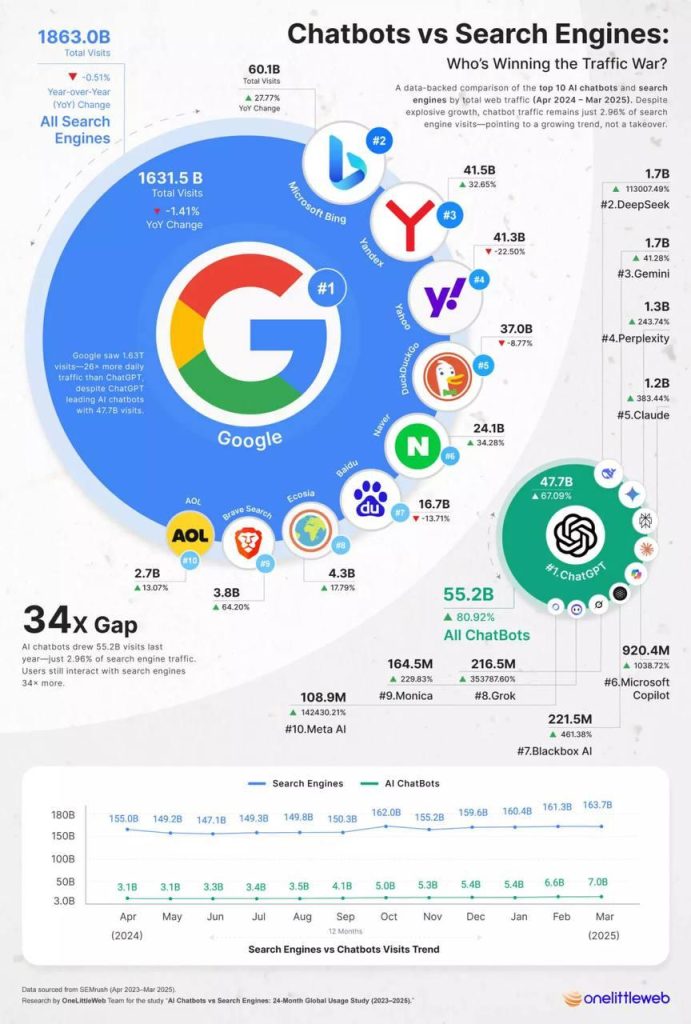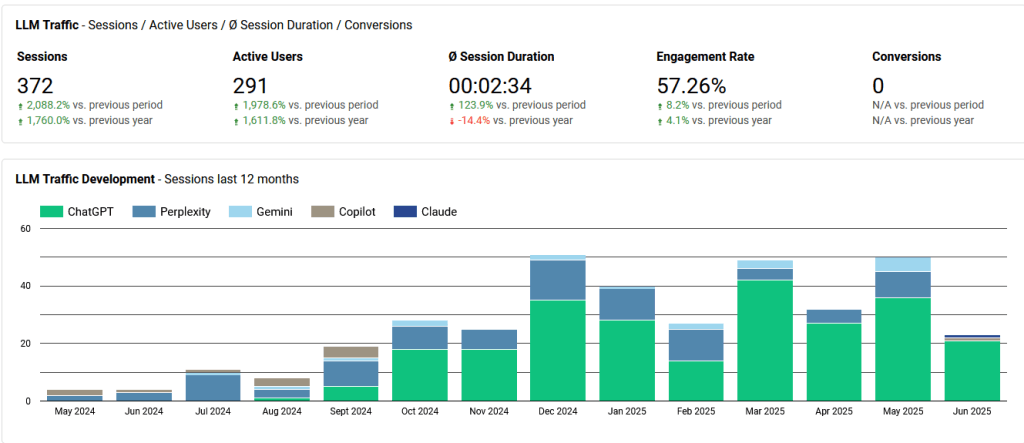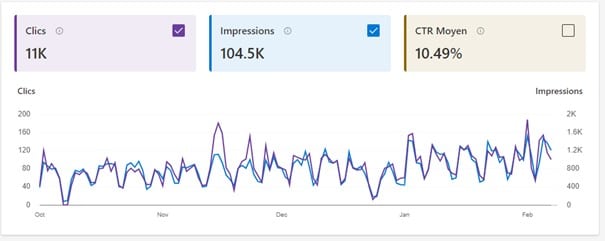This is exactly where this article comes in. As an SEO consultant who works with ChatGPT every day – both in my own agency and for clients – I’ll show you what really works right now. You’ll learn how to create content that is not only visible to artificial intelligence but also trustworthy, citable, and recommendable.
So if you want your site to appear in ChatGPT’s answers – you’re in exactly the right place.
When your best salesperson suddenly turns out to be a bot

Measuring AI traffic: we’re already doing it!
More and more visitors today don’t come through Google in the traditional way but via AI systems like ChatGPT, Perplexity, or Bing CoPilot. These new traffic sources remain invisible in Google Search Console – but they can absolutely be detected in Google Analytics if you know what to look for.
We’ve developed our own reports that show exactly which AI the traffic is coming from – for example, via referrers like chat.openai.com, perplexity.ai, or copilot.microsoft.com. These insights are pure gold: they help us understand which content is being recommended or cited by AIs like ChatGPT – and where SEO investments are most worthwhile.
Anyone who wants to know how visible their website truly is today can’t just look at traditional rankings. Visibility in LLMs is becoming the new competitive advantage – but only if you can measure and analyze it.
Our tip: Create your own GA4 dashboards or use tools like Looker Studio to analyze this traffic specifically and detect trends early on.

- Which traffic comes directly from AIs (yes, that’s possible!)
- Which URLs are most popular with ChatGPT & others
- Whether these users actually convert or just stop by to say hello
Here are the 12 techniques to generate AI traffic (and seduce the AIs)
Bing Webmaster Tools: ChatGPT’s secret backdoor
Bing is Microsoft’s search engine – and although it long lived in Google’s shadow, it’s rapidly gaining importance in the age of AI. The reason: Microsoft was quick to enhance Bing with artificial intelligence, particularly through the integration of ChatGPT into Bing CoPilot. As a result, Bing is no longer used solely as a traditional search engine but also as an interactive AI assistant that summarizes content, makes recommendations, and delivers direct answers.
For SEO, this means that Bing is no longer just “the other search engine,” but an increasingly relevant traffic source, especially for users of Windows, Edge, and CoPilot. Those who rank well on Bing – and especially appear in AI-generated results – secure visibility in a world beyond traditional Google search behavior. Additionally, competition is often lower, making it a great opportunity for smaller websites to appear faster and be recommended by AI.
In short: Bing isn’t dead – Bing got smart. And anyone who wants AI traffic should definitely keep Bing on their radar.

- Submit your site to the Bing Webmaster Tools
- Upload your sitemap and fix any errors
- Optional: If you run a shop – head to the Bing Merchant Center
Technical SEO: the good old code becomes an AI magnet
Before an AI can recommend your content, it first needs to understand it. And for that, it needs one thing: structure. No creative chaos, no design overload – just clear, clean code, well-organized headings, meaningful internal links, and a website that runs smoothly on every device.
Large language models like ChatGPT or Claude may be impressively intelligent, but they’re also technically very precise. They analyze your HTML, detect semantic patterns, crawl through your link structure – and evaluate how tidy your implementation is. Sounds nerdy? It is. And that’s exactly why technical SEO is becoming more important than ever.
Anyone who wants to be recommended by AIs in the future needs more than just great content: the foundation has to be solid. That means no messy code, no duplicate H1s, no CSS chaos. Those who keep things clean not only improve their chances of ranking well – but also of earning a spot in AI-generated answers.
- A lightning-fast website (no one likes a slowpoke)
- Clean H1–H3 hierarchy
- Internal links that make sense
- Mobile friendliness – so even Claude can handle it on a phone
Trust backlinks: because even machines need someone to believe in
In a world full of AI-generated content, auto-filled pages, and mass-produced SEO text, one thing matters more than ever: real recommendations. And in the digital space, that means one thing above all – backlinks.
When a reputable, topically relevant website links to you, it’s like a digital trust signal for Google, Bing & Co.: “Hey, this content is valuable.” But it’s not just search engines that pay attention. Artificial intelligences like ChatGPT also analyze the web’s link structure to determine which sources are trustworthy and relevant.
Especially important: links from strong, authoritative sites. They not only boost traditional SEO but also increase your chances of being cited or even recommended by LLMs (like ChatGPT or Claude) as a source.
In short: backlinks aren’t old-school SEO – they’re the new quality seal in the age of AI. Those who invest now in strong, topically relevant links don’t just build reach, they build digital authority that even machines trust.
As an international SEO agency, we have thousands of premium backlink and media contacts in our portfolio.
- Wikipedia (we’ll even write the article and create a Wikipedia entry for you)
- YouTube links in video descriptions – even if you only have one video on YouTube
- Reddit (subreddits with brains, not just memes)
- Reputable online media (our portfolio includes thousands of respected PR websites worldwide)
Mentions without links: feed the LLMs
- Forums
- Industry blogs
- Comment sections
- News portals
Content with context: no more keyword bingo
FAQ content: ChatGPT loves questions — you deliver the answers
- clear structure
- natural language
- lots of long-tail keywords
E-E-A-T: authority for Google and AIs

- Profile with photo, bio, and qualifications
- Links to social media (LinkedIn is enough)
- All content is published “by” this person
Content maintenance: old but gold is boring
- Update regularly
- Add current years (“Comparison 2025”)
- Expand content instead of rewriting it
With Google Search Console, you can easily find out which of your older blog posts still have real potential — and then optimize those articles specifically. Under “Performance,” look at which queries individual URLs are already getting impressions for but few clicks. That tells you: Google considers the content relevant — but something’s missing to make users actually click. Maybe the title isn’t compelling enough, the content is outdated, or the main keyword isn’t clearly defined.
In my SEO workshop, you’ll learn step by step how to identify, analyze, and refresh these potential posts — so they not only rank better but also start bringing in real traffic again.
Build topic clusters: islands of content instead of lone fighters
- Main page: “Heavy-duty shelves for basements”
- Supporting pages: “Moisture-resistant,” “corner solutions,” “with wheels”
- Everything internally linked
Use AI yourself: hack the hacker
Want to be recommended by AIs? Then work with them!
- Create your own GPTs (e.g., “Shelf Advisor”) featuring your brand
- Engage in AI forums and subreddits (yes, it really works)
- Let ChatGPT analyze and optimize your own content
Those who work with AI understand better how it thinks — and can influence it more effectively.

Structured Data: Whisper Information Directly into Google & ChatGPT’s Ear
- Product
- Article
- FAQPage
- Person / Author
- LocalBusiness
Cool Tip: Let ChatGPT Generate the Schema Code for You Directly!
Think in Content Formats: Multimodal is the New Standard
- Blog post
- Explainer video on YouTube – naturally embedded in your blog post (time on site increases, Google thinks you’re relevant and interesting)
- Infographic
- PDF download